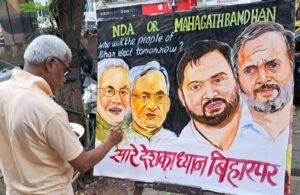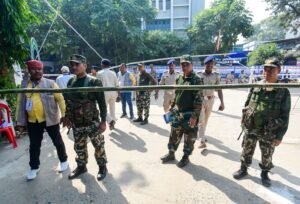
Srinagar: The abrogation of Article 370 on August 5, 2019, marked a historic shift in Jammu & Kashmir’s (J&K) political and constitutional status, removing its special autonomy and integrating it more directly into India’s legal framework. The move was highly controversial, and its impact on reducing tensions in J&K is debated. Here’s how the abrogation has been argued to help ease tensions, along with challenges that remain:
1. Enhanced Governance and Direct Control
- Integration into India’s Legal Framework: By removing Article 370, the central government gained greater control over J&K, allowing for more uniform application of laws. This has been seen as a step towards establishing better governance, law, and order, which in turn could contribute to reduced tensions.
- End of Separate Constitution: The abolition of the separate constitution for J&K meant that Indian laws, including those regarding security, anti-terrorism, and public order, could be directly applied. This allowed the government to strengthen counter-terrorism operations and maintain security more effectively, leading to a perceived decline in separatist sentiments in certain areas.
2. Curbing Separatism and Militancy
- Reduced Space for Separatist Movements: The abrogation of Article 370 weakened the political space available to separatist groups and leaders, many of whom had leveraged J&K’s special status to push for greater autonomy or independence. The central government’s direct administration, through the Union Territory structure, curtailed the influence of pro-separatist factions.
- Crackdown on Terror Financing: Following the abrogation, the government implemented stricter measures to curb terror financing and dismantle networks that supported militancy. Several separatist leaders were arrested, and funding sources for militancy were targeted. These actions have been viewed as a means to reduce insurgency and terrorist activity in the region.
3. Security Forces and Law Enforcement
- Strengthening of Security Operations: The abrogation allowed for a more coordinated effort between the central security forces and local law enforcement agencies. Enhanced cooperation has led to several high-profile operations against militants and the dismantling of insurgent networks, which has contributed to a relative decrease in violence.
- Calming Civil Unrest: In the immediate aftermath of the abrogation, curfews, internet shutdowns, and restrictions were imposed to maintain law and order and prevent mass protests. While these measures were criticized as heavy-handed, they were argued by the government to have helped contain the unrest and prevent large-scale violence.
4. Development and Economic Integration
- Investment in Infrastructure and Development: The central government has emphasized the development of infrastructure, job creation, and tourism to address long-standing grievances related to economic disparity. The focus on developmental initiatives is seen as an attempt to win over public support and shift attention away from separatism toward economic opportunities.
- New Investment Policies: With the abrogation of Article 370, businesses from outside J&K are now allowed to invest in the region, potentially leading to job creation and economic growth. These investments are intended to provide young people with alternatives to militancy, thus reducing long-term tension.
5. Diluting the Role of Political Elites
- Reduction in Power of Regional Elites: The special status had allowed a select group of political families and elites to dominate J&K’s politics for decades. The abrogation weakened their influence, and by dissolving the state legislature, it allowed for new political alignments. The government aimed to democratize local governance and give voice to previously marginalized communities.
- Elections and Grassroots Democracy: The government’s effort to hold Panchayat and District Development Council (DDC) elections post-abrogation was a step to decentralize power and bring governance closer to the people. Encouraging political participation at the grassroots level is seen as an effort to reduce alienation and resentment, thereby mitigating tensions.
6. Restoration of Law and Order
- Decrease in Stone-Pelting Incidents: According to the government, there has been a significant decrease in incidents of stone-pelting and violent protests since the abrogation of Article 370. This reduction in street-level violence has been cited as evidence of improved law and order in the region.
- Improved Counterterrorism Efficiency: With enhanced intelligence-sharing and a centralized approach to security, there have been more effective counterterrorism operations, leading to a reduction in high-profile attacks in urban areas. This has created a perception of greater security, particularly in regions like Jammu and Ladakh.
7. Inclusion of Jammu and Ladakh
- Addressing the Concerns of Jammu and Ladakh: While the Kashmir Valley has seen more resistance to the abrogation, regions like Jammu and Ladakh have generally welcomed the move. These areas had long felt marginalized under the J&K political structure, which was seen as dominated by Kashmir-centric politics. The abrogation helped address some of their grievances by offering greater opportunities for development and political representation.
8. Reintegration with the National Mainstream
- Closer Integration with India: The abrogation is seen by supporters as a step towards full integration of J&K with the rest of India, both politically and economically. This reintegration is expected to reduce feelings of alienation among certain sections of the population, as the region is brought under the same legal and constitutional framework as other Indian states.
Challenges That Persist:
While the abrogation of Article 370 has been seen by the government as a means to douse tensions, several challenges remain:

- Ongoing Alienation in the Valley: Despite the central government’s efforts, there is still significant opposition to the abrogation within the Kashmir Valley. Many residents feel their identity and political autonomy have been eroded, which could fuel long-term resentment.
- Militant Activity Continues: Although there has been a reported decrease in large-scale attacks, militant activity has not been fully eliminated, and sporadic violence continues in the region.
- Human Rights Concerns: The heavy security measures imposed post-abrogation, including prolonged internet blackouts, curfews, and restrictions on movement, have raised concerns about human rights violations, potentially deepening mistrust between locals and the central government.
- International Reactions: The international community, including Pakistan, has criticized the move, and the ongoing border tensions between India and Pakistan remain a source of instability in the region.
The abrogation of Article 370 has been framed as a necessary step to bring J&K into India’s full constitutional fold and to quell long-standing separatist tendencies. While the move has helped strengthen governance, curb the influence of separatist groups, and boost security operations, its effectiveness in fully dousing tensions is still a matter of ongoing debate. Some improvements have been seen in law and order, infrastructure development, and regional integration, but challenges such as public discontent in the Kashmir Valley and persistent militant activities remain.








